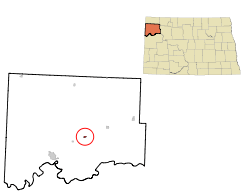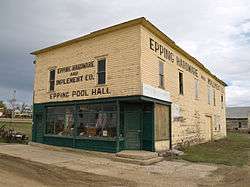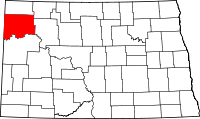Epping, North Dakota
| Epping, North Dakota | |
|---|---|
| City | |
|
Epping Hardware | |
| Motto: "The "Biggest" Little On The Great Northern Railroad" | |
 Location of Epping, North Dakota | |
| Coordinates: 48°16′51″N 103°21′29″W / 48.28083°N 103.35806°WCoordinates: 48°16′51″N 103°21′29″W / 48.28083°N 103.35806°W | |
| Country | United States |
| State | North Dakota |
| County | Williams |
| Area[1] | |
| • Total | 0.38 sq mi (0.98 km2) |
| • Land | 0.38 sq mi (0.98 km2) |
| • Water | 0 sq mi (0 km2) |
| Elevation | 2,215 ft (675 m) |
| Population (2010)[2] | |
| • Total | 100 |
| • Estimate (2014)[3] | 88 |
| • Density | 263.2/sq mi (101.6/km2) |
| Time zone | Central (CST) (UTC-6) |
| • Summer (DST) | CDT (UTC-5) |
| ZIP code | 58843 |
| Area code(s) | 701 |
| FIPS code | 38-24540 |
| GNIS feature ID | 1028896[4] |
Epping is a city in Williams County, North Dakota, United States. The population was 100 at the 2010 census.[5]
Epping was founded in 1905 along the transcontinental rail line of the Great Northern Railway. The name comes from the city of Epping in England.[6]
Geography
Epping is located at 48°16′51″N 103°21′29″W / 48.28083°N 103.35806°W (48.280762, -103.358139).[7]
According to the United States Census Bureau, the city has a total area of 0.38 square miles (0.98 km2), all of it land.[1]
Demographics
| Historical population | |||
|---|---|---|---|
| Census | Pop. | %± | |
| 1920 | 116 | — | |
| 1930 | 183 | 57.8% | |
| 1940 | 154 | −15.8% | |
| 1950 | 158 | 2.6% | |
| 1960 | 151 | −4.4% | |
| 1970 | 140 | −7.3% | |
| 1980 | 104 | −25.7% | |
| 1990 | 64 | −38.5% | |
| 2000 | 79 | 23.4% | |
| 2010 | 100 | 26.6% | |
| Est. 2015 | 85 | [8] | −15.0% |
| U.S. Decennial Census[9] 2014 Estimate[3] | |||
2010 census
As of the census[2] of 2010, there were 100 people, 37 households, and 27 families residing in the city. The population density was 263.2 inhabitants per square mile (101.6/km2). There were 40 housing units at an average density of 105.3 per square mile (40.7/km2). The racial makeup of the city was 81.0% White, 11.0% Native American, 5.0% Asian, and 3.0% from two or more races.
There were 37 households of which 37.8% had children under the age of 18 living with them, 67.6% were married couples living together, 2.7% had a female householder with no husband present, 2.7% had a male householder with no wife present, and 27.0% were non-families. 24.3% of all households were made up of individuals and 5.4% had someone living alone who was 65 years of age or older. The average household size was 2.70 and the average family size was 3.26.
The median age in the city was 39.5 years. 31% of residents were under the age of 18; 4% were between the ages of 18 and 24; 20% were from 25 to 44; 33% were from 45 to 64; and 12% were 65 years of age or older. The gender makeup of the city was 49.0% male and 51.0% female.
2000 census
As of the census of 2000, there were 79 people, 33 households, and 23 families residing in the city. The population density was 207.7 people per square mile (80.3/km²). There were 41 housing units at an average density of 107.8 per square mile (41.7/km²). The racial makeup of the city was 94.94% White and 5.06% Native American.
There were 33 households out of which 30.3% had children under the age of 18 living with them, 63.6% were married couples living together, 3.0% had a female householder with no husband present, and 30.3% were non-families. 27.3% of all households were made up of individuals and 12.1% had someone living alone who was 65 years of age or older. The average household size was 2.39 and the average family size was 2.96.
In the city the population was spread out with 22.8% under the age of 18, 6.3% from 18 to 24, 25.3% from 25 to 44, 34.2% from 45 to 64, and 11.4% who were 65 years of age or older. The median age was 43 years. For every 100 females there were 102.6 males. For every 100 females age 18 and over, there were 103.3 males.
The median income for a household in the city was $29,167, and the median income for a family was $33,125. Males had a median income of $28,542 versus $23,125 for females. The per capita income for the city was $14,167. There were 19.0% of families and 22.7% of the population living below the poverty line, including 38.1% of under eighteens and none of those over 64.
Climate
According to the Köppen Climate Classification system, Epping has a semi-arid climate, abbreviated "BSk" on climate maps.[10]
References
- 1 2 "US Gazetteer files 2010". United States Census Bureau. Retrieved 2012-06-14.
- 1 2 "American FactFinder". United States Census Bureau. Retrieved 2012-06-14.
- 1 2 "Population Estimates". United States Census Bureau. Retrieved May 29, 2015.
- ↑ "US Board on Geographic Names". United States Geological Survey. 2007-10-25. Retrieved 2008-01-31.
- ↑ "2010 Census Redistricting Data (Public Law 94-171) Summary File". American FactFinder. United States Census Bureau. Retrieved 2 May 2011.
- ↑ Wick, Douglas A. "Epping (Williams County)". North Dakota Place Names. Retrieved 8 May 2011.
- ↑ "US Gazetteer files: 2010, 2000, and 1990". United States Census Bureau. 2011-02-12. Retrieved 2011-04-23.
- ↑ "Annual Estimates of the Resident Population for Incorporated Places: April 1, 2010 to July 1, 2015". Retrieved July 2, 2016.
- ↑ "U.S. Decennial Census". Census.gov. Retrieved May 25, 2014.
- ↑ Climate Summary for Epping, North Dakota

